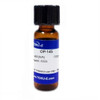OP-145 (syn: (acetyl-IGKEFKRIVERIKRFLRELVRPLR-amide) is a synthetic antimicrobial peptide (AMP) developed from the human cathelicidin LL-37. OP-145 consists of 24 amino acids and has demonstrated antibacterial and cytotoxic properties. It was synthesized by Shanghai Apeptide Co. Ltd. (Shaghai, China).
AMPs usually can accelerate immune defenses and wound healing ability in vivo, making them an alternative candidate to traditional antibiotics.
| Mechanism of Action | OP-145 interacts with phospholipids in bacterial and mammalian cell membranes leading to membrane thinning and permeabilization. |
| Microbiology Applications |
OP-145 strongly reduced growth and biofilm formation of clinically isolated drug-resistant strains, including MRSA, in vitro (Ming and Huang, 2017). Researchers found that phospholipid-driven differences in incorporation of OP-145 into the lipid bilayers govern the membrane activity of the peptide on bacterial and mammalian membrane model systems (Malanovic et al, 2015). |
| Spectrum | OP-145 is active against Staphylococcus aureus at 0.8-1.6 µM and may be effective against other Gram-positive bacteria. |
| Molecular Formula | C142H246N46O31 |
| References |
Malanovic N et al (2015) Phospholipid-driven differences determine the action of the synthetic antimicrobial peptide OP-145 on Gram-positive bacterial and mammalian membrane model systems. Biochim Biophys Acta. 1848(10 Pt A):2437-2447 PMID 26210299 Ming L and Huang JA (2017) The antibacterial effects of antimicrobial peptides OP-145 against clinically isolated multi-resistant strains. Jpn J Infect Dis. 70(6):601-603 PMID 28890511 Nermina M et al (2015) Phospholipid-driven differences determine the action of the synthetic antimicrobial peptide OP-145 on Gram-positive bacterial and mammalian membrane model systems. Biochimica Et Biophysica Acta (BBA) - Biomembranes 1848 (10):2437-2447
|



